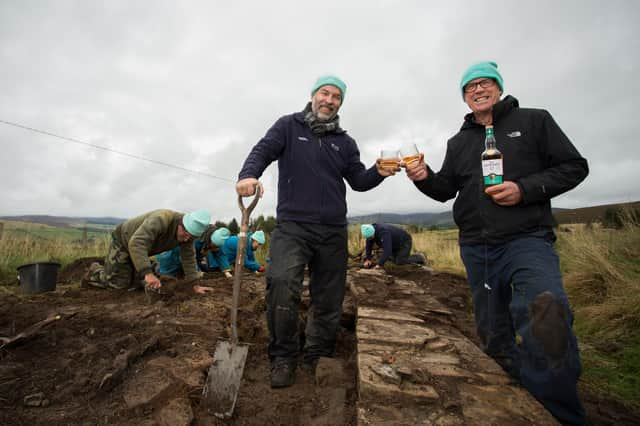Secrets of distillery where 'life and liberty' risked to make whisky unravelled


Archaeologists are excavating the original Glenlivet distillery, which sits around one kilometre uphill from the current site, where George Smith turned his illegal whisky-making operation into one of the bedrocks of the global business we know today.
The team from National Trust for Scotland has returned to Upper Drumin in Speyside, to start piecing together the story of Smith’s operation, which went legal following the 1823 Excise Act.
Advertisement
Hide AdAdvertisement
Hide AdSo far, the original flagstone’s from Smith’s distillery, which was built on his farm, have been discovered, as well as pieces of glass bottle and ceramic believed to be linked to his whisky-making enterprise.
Derek Alexander, head of archaeology at National Trust for Scotland’s Head of Archaeology has a long association with the the site and conducted a survey of the distillery remains in the 1990s.
He said: “Returning to this place after nearly 25 years to finally uncover the remains of this special place is really inspiring.
"Brushing dirt from the flagstones where George Smith, one of the lead figures of Scotland’s whisky industry, stood was incredible.
“What’s really interesting is that this is where the illicit production of whisky, which is what we find evidence of on our National Trust for Scotland sites, and the transition towards larger scale industrial production meet; a formative part of the whisky industry becoming one of Scotland’s biggest and most successful.
"It’s such a powerful part of our national story and identity, which is loved and recognised, at home and around the globe.”
According to whisky writer Iain Russell, around 2,000 people lived in Glenlivet in the 1820s with more than 100 small illegal stills at work deep in a landscape that was hard to reach by excise men.
Russell, in an account for the Edinburgh Whisky Academy, recalled the claims of a former smuggler, who said: “I suppose there were not three people in Glenlivet in those days who were not engaged directly or indirectly in the trade.”
Advertisement
Hide AdAdvertisement
Hide AdGeorge Smith, became one of many new ‘entered’ – or legal – distillers who faced hostility and the threat of violence from their neighbours who continued to work outwith the law.
Smith installed an armed guard at Upper Drumin after he received threats to burn down his premises. Soliders were then brought in to support excise officers, with the trade in illegal Glenlivet widely stamped out by the 1830s, Russell wrote.
Today, the site, which sits on Crown Estate Scotland land, is marked by an inscribed monument marking its important role in whisky history.
The excavation at Upper Drumin is part of the Pioneering Spirit project between National Trust for Scotland and The Glenlivet, which is investigating the impact of whisky production on Scotland’s cultural heritage and our modern way of life.
Alan Winchester, The Glenlivet’s Master Distiller said: "The majority of my career has been spent continuing the legacy of our founder George Smith, so it’s really interesting to have the opportunity to uncover even more secrets about our illicit past and tell new stories about the role Scotch has played in defining Scottish culture.”